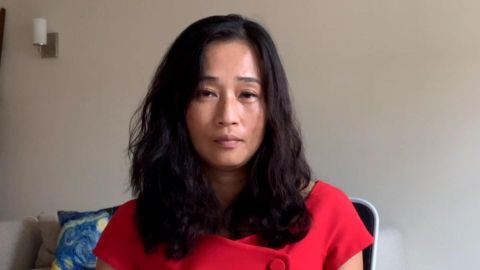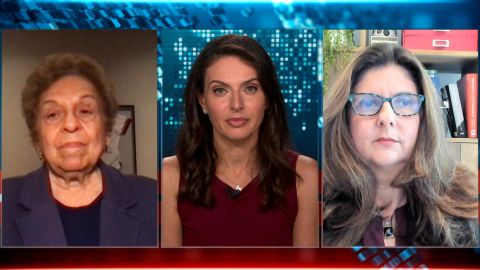Read Transcript EXPAND
BIANNA GOLODRYGA: Well, turning now to COVID-19, which is now the deadliest pandemic in the history of the United States. Over 681,000 Americans have died from the virus. That’s more than in the 1918 flu. And our next guest is seeing this unfold in front of her eyes. Kathryn Sherman is a critical care nurse in Nashville, Tennessee, the state with the most COVID cases per capita. In a piece for “The Atlantic,” and “The Scientific American,” she says the patients don’t stop coming. Here she is speaking to Hari Sreenivasan about what it’s like caring for the sickest patients.
(BEGIN VIDEOTAPE)
HARI SREENIVASAN: Thanks, Bianna. Nurse Kathryn Sherman, thanks so much for joining us. Part of why we’re having this conversation right now is that there are a lot of people in the country who are still kind of in that spring state of mind, that we are over this pandemic. They might not see it in their immediate communities. But you’re in Tennessee. You have been working as an ICU nurse. What’s it like in your hospital right now?
KATHRYN SHERMAN, CRITICAL CARE NURSE: It’s worse than it’s ever been, both by the numbers and anecdotally. We have more COVID patients than we have ever had before. More of them are on ventilators than they have ever been before. They’re coming in younger and much sicker. They’re needing to be intubated much more quickly. It’s worse than it’s ever been. And it blew my mind last year that I would leave the hospital and see people on party buses and crowding up and down Broadway acting like nothing’s happening. And it hits even worse now, because it is so much worse inside the hospital, and people are still just acting like it’s all a game or like it’s not happening at all.
SREENIVASAN: So, let’s talk a little bit about how the composition of your patients have changed, when it came to December or January vs. today. Who are you treating?
SHERMAN: Right now, we’re treating people in their 30s to early 50s. We do still, of course, have people in their 60s, 70s and 80s. But whereas, last winter, the people in their 70s and 80s made up probably the majority of my COVID patients — it was a rarity if I had somebody under the age of about 55 — nowadays, we have patients who are 55, 42, 49, one that was in their early 30s. We have had some very early 20s. And that just — that was much rarer this winter. And now that is the majority of our patient population.
SREENIVASAN: And we have heard this from so many parts of the country. Are the majority of the people who are ending up in the hospital or who have to be in the ICU unvaccinated?
SHERMAN: I have had one fully vaccinated patient through all of this. And that patient was — had extreme comorbidities and was immune- compromised. The rest of them are unvaccinated.
SREENIVASAN: And how frustrating is that? It’s — frustrating doesn’t even begin to cover it. And my anger is not it directed towards those patients because by the time you have someone roll up into the ICU on a BiPap, struggling to breathe, just terrified, you can’t be angry at that person because many of them just fell prey to, you know, all of these misinformation campaigns that have really been overwhelming people all across the country. And a lot of them did not recognize the severity of COVID until it came to their door.
SHERMAN: So, my anger is not directed at my patients because — by the time they come to me, they know better. But it’s really hard to see these people suffering immensely for weeks on end and know that there was a way for them to not suffer. It would have been very, very easy for them to not be in the ICU at all. For us, I mean, it’s with us all the time. Even when I’m not at work. I’m thinking about COVID. I’m thinking about my patients. You know, I go to the store and I see people without masks. And the first thing that pops in my head is, if you got COVID, you would probably die, you know, based orphan their age or whatever it might be. You know, that’s — I feel like I’m constantly triaging people based on whether or not they would survive COVID. And that’s not healthy. Like I’m very aware of how not healthy that is, but when I say, we carry this with us, it is always there. It didn’t have to be. We could have been through it.
SREENIVASAN: Describe for me, most people have not been into an ICU and we’re fortunate, but when you’re on a shift, what are the sounds, what are the sights, what are you living through for all those hours?
SHERMAN: So, right now, we have something like 35 ICU beds. Last time I was there, every single patient except for one was on a ventilator. You hear a lot of alarms. It’s constant alarms. And it’s a little bit surreal right now because, like I said, all of our patients are on ventilators. So, normally, even in the ICU, you know, you hear call bells where the patient will use the call light to call the nurse say like, I need help going to the bathroom or, you know, I need some water, what have you. There’s no call bells anymore. None. It’s just those red alarms for, you know, dangerously low oxygen saturation or dangerously high heart rate.
SREENIVASAN: Tell me about a patient that stands out. I know you have dealt with so many, but what’s one that comes to mind?
SHERMAN: There was one a couple weeks ago who was — she was on the younger end and she had been on BiPap for a couple days by the time I had her and she was doing really, really well. And the thing with COVID that is so awful is we know exactly what’s going to happen and we still can’t stop it. There are signs that are very, very clear that we all recognize when a patient is going to go downhill. And this patient had been so well and then I started to see those signs. And it’s just this like dread that hits in your chest because, you know, she was the nicest lady. It’s always the nice ones. Just the sweetest, sweetest lady. You know, and I started seeing her oxygen start going down more and more and it took her longer and longer to recover. And when I was doing my last check in the morning before I left, you know, she kind of grabbed my hand and she had that BiPap on, so her voice was really muffled and she just said, I don’t want you to go. And I knew in my gut that the next time I saw her, she was going to be intubated. You know, and I was right. When I came back for my next shift two days later, she was intubated. And it just — I remember them all. I don’t remember all their names, but I remember all of them, and they are all sad.
SREENIVASAN: You are working in a state where I want to say right now the vaccination rate is about 44 percent. And when we look back at the past couple weeks, the number of deaths is up 120 percent. This doesn’t seem to be turning the corner. What are you afraid could happen in Tennessee?
SHERMAN: I think it’s just going to keep getting worse. You know, like you said, we — our vaccination rate is pretty abysmal. Our governor has not done anything to contain the spread of the virus, adamantly against like mask mandates for schools, even for individual schools putting in mask mandates. Adamantly against any sort of — not even a full lockdown but any sort of restrictions on gatherings. Mitigation measures here are slim to none. And viruses are exponential. You know, that’s how they work. That’s what they do. And until something changes, numbers are going to keep going up. You know, I saw my mother yesterday and she asked me if things had gotten any better at work and I was like, no, it’s getting worse. And that scares me because we have already almost run out of ventilators. We have already run out BiPaps, out Vapotherms. We’ve already had to keep ventilated patients on medical surgical floors, which are not equipped to handle ventilated patients. Our poor ERs are filled with ICU holes, which means that an ER nurse who is already responsible for caring for five or six emergency room patients also has to take care of an ICU patient who is being held down in the ER. The health care system can only bend so far before it breaks. And we’re pressing that button pretty hard right now. I’m not excited about seeing what happens if it gets worse, when it gets worse.
SREENIVASAN: Are your ICU wards full?
SHERMAN: Yes, we are over capacity. We have been over capacity for weeks.
SREENIVASAN: So, there is a reason they are called intensive care units. Now, what happens when you’re over capacity? What happens to that patient that needs it but when there’s no space in had that ward?
SHERMAN: Sometimes they die. There have been multiple instances, none that I can think of at my hospital, but around the country, there’s multiple instances of patients in the ER, have needed an ICU bed and there have been none available within 100 miles. And so, they die. You know, we have had patients at my facility who required some sort of like specialist care, you know, some sort of care that my hospital didn’t offer, like a specialist physician or surgery, what have you. And all of the hospitals that offer those services are full. And so, these people are basically put on a waiting list. And when I say waiting list, what we mean is we are waiting for another patient in this specialty center to die so that bed opens up. Because with COVID patients, these people are in ICU beds for weeks. I mean, three weeks, four weeks, it is a long time. And, yes, we have had some success stories, but for the most part, that bed opens up when somebody dies. And I just — I want people to fully understand that because when we are waiting for somebody to be transferred, we are waiting for someone else to die. And that — just like as a nurse, that is so like viscerally upsetting to me, that my patient getting quality care, getting the care they need depends on somebody else’s patient dying. That’s horrific.
SREENIVASAN: Take me into the break room, if you will, after you’re seeing these patients. What are you nurses, ICU nurses, critical care nurses talking about?
SHERMAN: A lot of it is us talking about the fact that we don’t want to do this anymore. Whether this is nursing in general, whether this is COVID, whether it’s all of the denialism and misinformation surrounding COVID. You know, I have heard so many of my co-workers say, you know, I just don’t want to do this anymore. And a lot of times we say it jokingly, but there’s also that edge of like real trauma, for lack of a better word, underneath it. Nurses are angry. Like I have seen very calm veteran, seasoned nurses just mad as all get out over this because they are angry at the fact that we still have to do this. They are angry at the fact that, you know, we are still putting ourselves at risk, our families at risk by constant constantly being exposed to these patients, who, for one reason or another, have not taken the steps to protect themselves. You know, you can only do that so many times before something in you just breaks, and you’re angry all the time.
SREENIVASAN: You know, there was a recent survey of more than 6,000 acute and critical care nurses done by the AACCN. And some of the numbers that I just want to look at here. 92 percent of nurses surveyed said they believe the pandemic has depleted nurses at their hospitals. And as a result, their careers will be shorter than they intended. Another one that was — that leapt out of me, 66 percent feel their experiences during the pandemic have caused them to consider leaving nursing. Now, you are kind of the freshest of nurses. You graduated right into this pandemic. So, have you had second thoughts?
SHERMAN: No, I haven’t. But I was made to be a nurse. That sounds really cheesy, but it’s honestly 100 percent true. Like this is the only thing that there is for me. I love it. I — even during all of COVID, I love it. For — there are a lot of fantastic nurses out there who do not feel the same way about nursing that I do, and that’s OK. You don’t have to. You don’t have to feel the way about nursing that I do to be a good nurse. But there are so many people who understandably so, the risks and the pain that comes with this are no longer — there are no longer enough benefits to weigh — to cancel it out. And I think that that is completely understandable. You know, I think that if you have to choose between your mental health and your job, you should choose your health every time. You know, nurses — nursing has always been a high turnover profession because hospitals have always burned through nurses. And this is a very long-standing issue that is beginning to come to light because there is such a dire need of nurses right now. But this is not a new issue.
SREENIVASAN: And I have to imagine here that if you are usually an ICU nurse that maybe just deals with one patient or possibly two, and you have to take care of three, just logistically speaking, does that mean —
SHERMAN: Oh, it’s a nightmare.
SREENIVASAN: Right. They’re getting less quality of care.
SHERMAN: Yes. That’s exactly the issue. I would say, typically, most two patients is difficult. If you have one patient, they are either on ECMO or something called CRRT or they have a balloon pump, things of that nature that just — you got to have eyes on that person all the time. Two is a very typical assignment. And, you know, in the ICU, our patients are on titratable medications where every five minutes you’re having to turn one medication up and another down in order to get their blood pressure where it needs to be, their heart rate where it needs to be, their sedation where it needs to be. So, you can imagine, if you have three patients, all of whom on ventilators and requiring titratable medications, you know, you’re — you don’t have time to do anything other than keep up with tasks. You don’t have time to support that patient emotionally. You don’t have time for thorough assessments. You don’t have time to communicate with the family members, the doctors, other members of the team. Care absolutely suffers. Even the best ICU nurses often struggle with being tripled because it’s simply unsafe.
SREENIVASAN: There’s a photo that you share on social media, and on the left side is this sort of young, vibrant, happy to be a nurse look. And then on the right side is perhaps you after a shift.
SHERMAN: I was pretty tired. Yes, it’s — I — that was actually in the middle of a shift. I think I had just gotten a COVID admission and had been in the room for about an hour. Wearing my respirator and goggles and a face shield and these like plastic gowns that just make you sweat buckets. And so, after I came out and took my PPE off, I just like went and hid in the bathroom for like five minutes just to get a minute to myself, to like cool down and drink some water. And I looked at myself in the mirror and I was like, wow, you look ratchet. You know, it just — and when — I remember when I looked at myself in the mirror, I actually had that image of my composite picture from nursing school in my head because I was thinking the same thing you did. I was like, you know, I remember like I had this twinkle in my eye. Like I’m almost done with nursing school and I’m going to be a nurse and COVID hasn’t — I don’t even know what coronavirus is yet. I was like, wow. At that point, there had been less than a year between those two pictures. It was like seven or eight months.
SREENIVASAN: What would you tell maybe to your younger self that the one that is in that picture, the one that’s about to graduate, or perhaps a young student that’s about to finish and come into nursing today?
SHERMAN: I’d tell them to buckle up and get ready. You know, like I said, I — to me, it is still worth it. You know, I — nursing is still worth it. But for a lot of people, it isn’t. And that’s OK. You know, I would tell them, know your limits. Know your boundaries. Know when you have to shut it down. When you have to shut your emotions down and just check out for a little bit because you’re going to see a tidal wave of death, and nothing prepares you for it.
SREENIVASAN: Nurse Kathryn Sherman, I’m sure you hear this all the time, but sincerely, thank you for staying in this profession and doing what you do. And best of luck through the rest of this. Thanks for joining us.
SHERMAN: Thank you. My pleasure.
About This Episode EXPAND
Donna Shalala; Betsey Stevenson; Lingling Wei; Kathryn Sherman; Mary Roach
LEARN MORE



